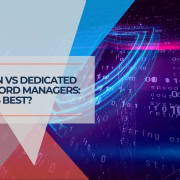The Definitive IT Playbook for Small Businesses
Last Updated on June 9, 2023
Step into a world where digital transformation takes center stage, reshaping how we do business. As the digital landscape continuously evolves, companies must swiftly adapt to new technologies to remain at the forefront of innovation. Dive into this guide with essential IT tools and resources to catapult your small business into a future filled with success and growth.

Table of Contents
- 1 Cloud Computing – Sky's the Limit
- 2 Cybersecurity – Protect Your Digital Fortress
- 3 Collaboration and Communication – The Future is Unified
- 4 CRM and Marketing Automation – Turbocharge Your Customer Journey
- 5 Data Analytics – Unleash the Power of Data-Driven Decision Making
- 6 Going Green – Embrace Sustainable IT Practices
- 7 Digital Transformation – Embracing the Future of Work
- 8 Continuous Learning – Stay Ahead of the Curve
- 9 IT Infrastructure – Building a Solid Foundation
- 10 Embracing Innovation – Cultivating a Culture of Change
- 11 The Future of Small Business IT – Embracing Emerging Technologies
- 12 Preparing for the Future – The Road Ahead
- 13 Building a Digital-first Mindset – The Key to Success
- 14 Conclusion – Embracing the Future of Small Business IT
Cloud Computing – Sky's the Limit
Embrace the Cloud
Gone are the days of clunky servers taking up valuable office space. Instead, cloud computing has changed the way we store and access data. By embracing cloud-based solutions, your small business can benefit from the following:
- Lower costs: Save on hardware, electricity, and maintenance.
- Scalability: Easily scale up or down based on your needs.
- Remote access: Access your data and applications from anywhere, anytime.
- Enhanced security: Cloud providers offer robust security measures to protect your data.
Choosing the Right Cloud Platform
Selecting the right cloud platform for your small business is essential to ensure smooth operations, scalability, and cost-efficiency. When evaluating cloud platforms, consider the following factors:
Types of Cloud Services
Cloud platforms offer various services, such as Infrastructure as a Service (IaaS), Platform as a Service (PaaS), and Software as a Service (SaaS). First, determine which type of service best suits your business needs:
- IaaS: Provides virtualized computing resources, such as servers, storage, and networking. Ideal for businesses looking for more control over their infrastructure.
- PaaS: Offers a platform for developing, testing, and deploying applications without managing the underlying infrastructure. Suitable for businesses focused on software development.
- SaaS: Delivers ready-to-use applications via the cloud, often with a subscription-based pricing model. Perfect for companies seeking to use software without managing infrastructure or software updates.
Features and Integrations
Consider the features and integrations different cloud platforms offer to ensure they align with your business requirements. Look for:
- Ensure the cloud platform offers scalability and flexibility to accommodate your business growth.
- Opt for a platform that seamlessly integrates your existing tools and applications. Prioritize robust data security and privacy features to protect your sensitive information.
- Finally, select a provider that offers comprehensive customer support and service level agreements (SLAs) to guarantee reliability and performance.1.2.3 Pricing and Costs
Cloud platforms offer various pricing models, such as pay-as-you-go, subscription-based, or fixed pricing. Carefully analyze the costs associated with each platform to ensure they fit your budget:
- Compare the pricing plans and features offered by different providers.
- Consider additional costs like data transfer, storage, or support fees.
- Evaluate the total cost of ownership (TCO), including direct and indirect costs, to make an informed decision.
Popular Cloud Platforms
Some popular cloud platforms for small businesses include:
Considering your business needs, requirements, and budget, you can select the right cloud platform to support your small business‘s growth and success in the digital age.

Cybersecurity – Protect Your Digital Fortress
Implement Robust Security Measures
Your small business's digital assets are only as secure as the measures you put in place. Implementing robust cybersecurity measures is crucial to protect your business from data breaches, ransomware, and phishing attacks. Here are some essential steps:
- Use strong, unique passwords for all accounts.
- Enable multi-factor authentication (MFA) wherever possible.
- Regularly update software and apply patches.
- Train employees on cybersecurity best practices and threat awareness.
- Invest in a reliable antivirus and firewall solution.
Secure Your Business with a VPN
A Virtual Private Network (VPN) creates an encrypted connection between your devices and the internet, ensuring that your data remains secure from prying eyes. Consider implementing a VPN for your small business to:
- Safeguard sensitive information during remote work.
- Enable secure access to your company's internal network.
- Protect against cyber threats on public Wi-Fi networks.

Collaboration and Communication – The Future is Unified
Streamline Collaboration with Project Management Tools
Efficient collaboration is crucial to your small business's success. Project management tools help streamline communication, delegate tasks, and track progress. Some popular project management solutions include:
Stay Connected with Unified Communications Solutions
In today's digital world, staying connected is more important than ever. Unified communications solutions integrate various communication channels into a single platform, such as voice, video, and messaging. Consider these popular options:

CRM and Marketing Automation – Turbocharge Your Customer Journey
Invest in a Customer Relationship Management (CRM) System
A CRM system helps you manage customer interactions and sales processes, enabling you to build better customer relationships. Some popular CRM platforms include:
Automate Your Marketing Efforts
Marketing automation tools can streamline your marketing efforts by automating repetitive tasks like email marketing, social media posting, and lead generation. Consider these popular marketing automation platforms:
Your small business can thrive in today's digital age by embracing the latest IT solutions and cybersecurity measures. Stay informed, stay connected, and adapt as new technologies emerge.

Data Analytics – Unleash the Power of Data-Driven Decision Making
Harness the Power of Business Intelligence Tools
In the information age, data-driven decision-making is crucial for small businesses. Business Intelligence (BI) tools can help you collect, analyze, and visualize data to make informed decisions. Some popular BI platforms include:
Leverage Data Analytics for Growth
Data analytics can provide insights into customer behavior, market trends, and internal processes, allowing you to optimize your business strategies. Consider implementing the following analytics practices:
- Set measurable goals and track relevant Key Performance Indicators (KPIs).
- Monitor customer behavior and preferences to improve customer experience and retention.
- Analyze internal processes to identify bottlenecks and areas for improvement.

Going Green – Embrace Sustainable IT Practices
Reduce Your Carbon Footprint with Energy-Efficient Hardware
Investing in energy-efficient hardware can reduce your small business's carbon footprint and save money on energy bills. Consider the following tips:
- Choose Energy Star-certified devices that meet strict energy efficiency guidelines.
- Implement power management settings to conserve energy during periods of inactivity.
- Consider using thin clients or virtual desktops, which consume less energy than traditional PCs.
Practice Responsible E-Waste Management
Electronic waste (e-waste) is a growing environmental concern. Be a responsible small business owner by disposing of e-waste properly:
- Recycle old electronics through certified e-waste recycling programs.
- Donate functional equipment to schools, non-profits, or community organizations.
- Choose cloud-based solutions to minimize hardware waste and reduce energy consumption.
Your small business can flourish in the ever-evolving digital landscape by staying on top of the latest IT trends, prioritizing cybersecurity, and embracing sustainable practices. Keep learning, stay agile, and adapt to new technologies as they emerge to ensure your business remains at the forefront of innovation.

Digital Transformation – Embracing the Future of Work
Implement Robotic Process Automation (RPA)
Robotic Process Automation (RPA) allows you to automate repetitive tasks, allowing your team to focus on more strategic and creative work. Consider implementing RPA tools to:
- Streamline data entry and reporting tasks.
- Automate invoice processing and other financial operations.
- Improve customer support with automated responses and chatbots.
Some popular RPA tools include:
Embrace Remote Work Technologies
As remote work becomes increasingly popular, you must equip your team with the right tools to collaborate and stay productive from anywhere. Keep these remote work technologies in mind:
- Cloud-based storage solutions like Dropbox or Google Drive.
- Virtual meeting platforms such as Zoom or Cisco Webex.
- Remote desktop access software like TeamViewer or AnyDesk.

Continuous Learning – Stay Ahead of the Curve
Invest in IT Training and Development
Investing in ongoing IT training and development for your team is crucial to maintain a competitive edge. Foster a culture of continuous learning by implementing the following strategies:
- Offering access to online learning platforms like LinkedIn Learning or Udemy.
- Allocating time and resources for employees to attend workshops, webinars, or conferences.
- Encouraging knowledge sharing through internal presentations or lunch-and-learn sessions.
Keep an Eye on Emerging Technologies
As technology evolves, staying informed about emerging trends and tools is crucial. This proactive approach can help your small business stay ahead of the curve and capitalize on new opportunities. Consider the following strategies:
- Subscribe to industry newsletters, blogs, or podcasts to stay informed about the latest IT trends.
- Network with other small business owners or IT professionals to share insights and experiences.
- Experiment with new technologies by implementing pilot projects or collaborating with startups.
Maintaining a forward-thinking mindset and embracing continuous learning will enable your small business to adapt and thrive in an ever-changing digital landscape. Stay informed, stay connected, and innovate as new technologies and opportunities arise.

IT Infrastructure – Building a Solid Foundation
Develop a Comprehensive IT Strategy
A well-defined IT strategy can guide your small business's technology investments and ensure they align with your overall business goals. Consider the following steps to create an effective IT strategy:
- Assess your current technology infrastructure and identify gaps or areas for improvement.
- Set clear objectives for your IT investments, such as improving productivity, enhancing customer experience, or increasing revenue.
- Develop a roadmap for implementing new technologies and upgrading existing systems.
- Allocate resources and establish a timeline for achieving your IT objectives.
Consider Managed IT Services
Managed IT services can provide your small business with cost-effective access to expert IT support and resources. In addition, by outsourcing some or all of your IT functions, you can benefit from the following:
- Your business will benefit from access to specialized expertise and industry best practices by opting for managed IT services. This will allow for an improved focus on core business activities.
- Additionally, managed IT services provide proactive monitoring and maintenance of your IT systems, ensuring their reliability.
- Lastly, with managed IT services, your business can enjoy predictable monthly IT support and services costs, simplifying budgeting and financial planning.

Embracing Innovation – Cultivating a Culture of Change
Foster a Culture of Innovation
Embracing innovation starts with cultivating a culture encouraging experimentation, risk-taking, and continuous improvement. Encourage your team to think creatively and challenge the status quo by:
- Creating an environment that supports collaboration and cross-functional teamwork.
- Recognizing and rewarding innovative ideas and initiatives.
- Encouraging open communication and providing opportunities for employees to share their thoughts and feedback.
Stay Agile and Adaptable
Agility and adaptability are critical for small businesses in today's rapidly changing digital landscape. Implement agile methodologies and practices to help your organization respond quickly to changes and seize new opportunities:
- Adopt iterative project management approaches, such as Scrum or Kanban.
- Encourage cross-functional collaboration and empower teams to make decisions.
- Continuously evaluate your processes and technologies to identify areas for improvement.
By fostering a culture of innovation and embracing agility, your small business will be well-positioned to adapt and thrive in an ever-evolving digital world. So stay informed, stay connected, and explore new technologies and opportunities as they emerge.

The Future of Small Business IT – Embracing Emerging Technologies
Artificial Intelligence (AI) and Machine Learning
Artificial Intelligence (AI) and Machine Learning are transforming businesses' operations, offering new opportunities for automation, personalization, and data analysis. Consider exploring AI and Machine Learning technologies to:
- Streamline customer support with AI-powered chatbots.
- Enhance your marketing efforts with personalized recommendations and targeted campaigns.
- Automate data analysis to identify trends and inform strategic decision-making.
The Internet of Things (IoT)
The Internet of Things (IoT) refers to the network of interconnected devices and sensors that collect and exchange data. IoT technologies can help small businesses improve operational efficiency, monitor assets, and deliver new services. Potential applications include:
- Monitoring inventory levels and supply chain management.
- Implementing smart energy management systems to reduce costs and environmental impact.
- Enhancing customer experiences with personalized, location-based services.
Blockchain Technology
Blockchain technology, best known for its role in cryptocurrencies like Bitcoin, offers innovative, secure data storage and transaction solutions. Small businesses can leverage blockchain technology to:
- Enhance supply chain transparency and traceability.
- Improve data security and integrity.
- Streamline payment processing and reduce transaction fees.

Preparing for the Future – The Road Ahead
Staying ahead of the curve is crucial for small business success in the rapidly evolving digital landscape. To ensure your small business is future-ready, consider the following strategies:
- Develop a long-term technology roadmap that aligns with your business goals and objectives.
- Encourage a culture of innovation and continuous learning, empowering your team to explore and embrace new technologies.
- Stay informed about emerging trends and technologies, and be prepared to adapt your business strategies as the digital landscape evolves.
Your small business can thrive in the ever-changing digital world by embracing the latest IT solutions, prioritizing cybersecurity, and staying at the forefront of emerging technologies. Continue to learn, stay connected, and adapt as new technologies and opportunities arise, positioning your business for long-term success.

Building a Digital-first Mindset – The Key to Success
Embracing Digital Transformation
In today's digital landscape, digital transformation is crucial for businesses of all sizes. Small businesses, in particular, must prioritize adopting and integrating new technologies. To initiate this transformative process, consider implementing these steps:
- Assessing your current digital maturity and identifying areas for improvement.
- Creating a digital transformation roadmap that outlines your goals, strategies, and timelines.
- Ensuring that your team is equipped with the necessary skills and resources to adopt new technologies effectively.
Integrating Digital and Physical Experiences
The line between online and offline experiences is becoming increasingly blurred. Small businesses must seamlessly integrate digital and physical experiences to deliver a consistent and engaging customer journey. Consider:
- Implementing omnichannel marketing strategies to reach customers across multiple platforms and touchpoints.
- Utilizing Augmented Reality (AR) and Virtual Reality (VR) to create immersive and interactive customer experiences.
- Leveraging IoT technologies to enhance in-store experiences and gather valuable customer data.
Building a Strong Digital Presence
In today's digital-first world, a robust online presence is essential for small businesses to build brand awareness, engage customers, and drive sales. Boost your digital presence by:
- Creating a user-friendly and mobile-responsive website.
- Developing a comprehensive social media strategy to engage with your target audience.
- Implementing Search Engine Optimization (SEO) and paid advertising strategies to increase visibility and drive traffic to your website.
Conclusion – Embracing the Future of Small Business IT
The world of small business IT is ever-evolving, presenting challenges and opportunities for those willing to adapt and innovate. Your small business can thrive in the digital age by staying informed, embracing emerging technologies, and fostering a culture of continuous learning.
As you embark on your IT journey, remember that success lies in staying agile, embracing change, and investing in the right tools and strategies to propel your small business into the future. Keep learning, stay connected, and never stop exploring the limitless potential of technology.











Leave a Reply
Want to join the discussion?Feel free to contribute!